
Sitka Grows Rhosgobel Discovery with Intersection of 166.0 Metres of 1.14 g/t Gold, Including 8.0 Metres of 4.86 g/t Gold, from Surface at Its RC Gold Project, Yukon

- Mineralized footprint of the Rhosgobel discovery rapidly expanding with visible gold observed in 16 of 22 drill holes completed over an approximately 900 metre strike extent of the 2.0 km x 1.5 km gold-in-soil anomaly
- Results received from the first 6 diamond drill holes ever completed at Rhosgobel have all returned >100 gram-metres (g/t*m) of gold
- DDRCRG-25-006 intersected 166.0 m of 1.14 g/t Au, including 8.0 m of 4.86 g/t Au, from surface
- DDRCRG-25-004 intersected 239.9 m of 0.60 g/t Au from surface, including 20.0 m of 1.02 g/t Au from surface, 18.0 m of 1.36 g/t Au from 100m and 14.1 m of 1.06 g/t Au from 138.8 m
- 22,677 m in 62 holes completed to date at RC Gold in 2025 with four diamond drills currently active on the Project; assay results currently pending for 48 holes
Sitka Gold Corp. (TSX-V: SIG) (FSE: 1RF) (OTCQB: SITKF) is pleased to announce additional positive assay results from the Rhosgobel discovery at its 100% owned, road accessible RC Gold Project located in the Yukon’s prolific Tombstone Gold Belt. The mineralized footprint of the Rhosgobel discovery is rapidly expanding with visible gold observed in 16 of the 22 holes drilled to date over approximately 900 metres of strike length within the 2.0 km x 1.5 km target outline represented by the >500 ppb gold-in-soil anomaly (see Figure 3). To date, results for just six of the 22 diamond drill holes completed at Rhosgobel have been received with all six holes returning >100 gram-metres (gold grade x length) intervals, including holes 004 and 006 in this release (see news releases dated November 25, 2024 and August 5, 2025). To date 6,438 of the planned 10,000 metres of drilling have been completed at the Rhosgobel discovery as part of the 30,000 metre, fully funded diamond drill program currently underway at RC Gold. Assay results are currently pending for 48 holes.
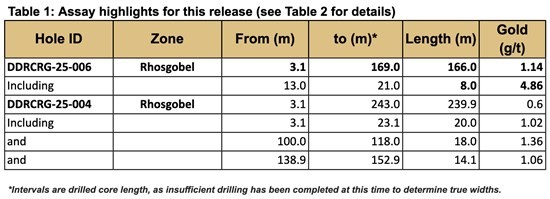
“Drilling at Rhosgobel, which is the largest intrusion within the Clear Creek Intrusive Complex, continues to confirm that we have made a very significant gold discovery,” said Cor Coe, Director and CEO of Sitka Gold. “We are still at an early stage of drilling at Rhosgobel yet we already have multiple occurrences of visible gold observed in several drill holes that are located along a 900 metre strike of the interpreted zone, with the first six diamond drill holes ever drilled on this target all returning intersections that are greater than 100 gram-meters (g/t*m) of gold. The potential for the Rhosgobel intrusion to host a large, multi-million ounce gold deposit similar to other known deposits in the Tombstone Gold belt is becoming more evident with these recent results. The gold endowment of the RC Gold Project is growing rapidly, driven by our latest discovery at Rhosgobel alongside our known deposits at Blackjack and Eiger, which both remain open for expansion. With advanced drill targets at Saddle, Pukelman-Contact, and the Bear Paw Breccia, plus a strong pipeline of additional targets and grassroots potential across our 431-square-kilometre, road-accessible claim block, the potential for further resource growth at RC Gold is significant.”
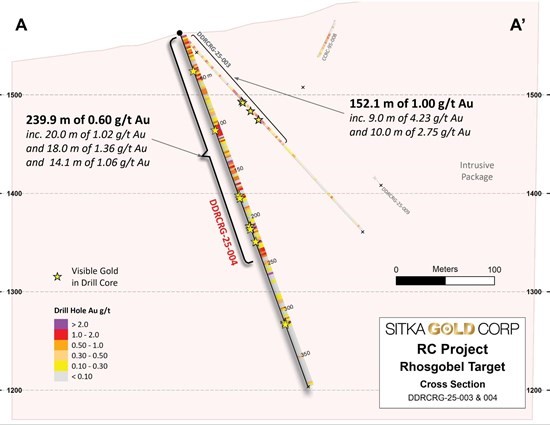
Figure 1: A cross section of holes DDRCRG-25-003 and 004. Analytical results show strong gold values intersected in hole 004 with an average of 1.02 g/t gold over 20.1m starting from the surface within the broader interval grading 0.6 g/t gold over 238.0 m from surface.
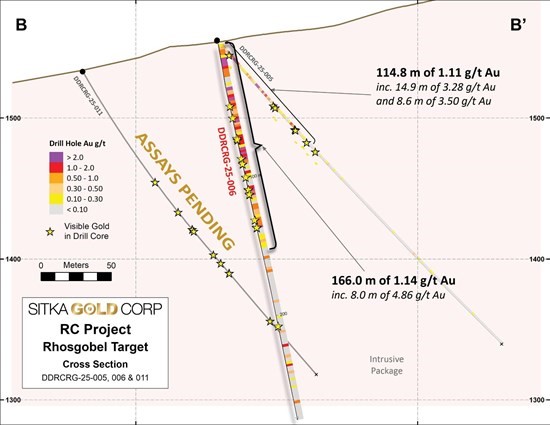
Figure 2: A cross section of holes DDRCRG-25-005, 006 and 011 showing >1 g/t gold mineralization starting from surface. All holes intersected similar mineralization with highlight assays displayed for Hole 006 returning 1.14 g/t gold over 166.0 m including 8.0 m of 4.86 g/t gold from surface.
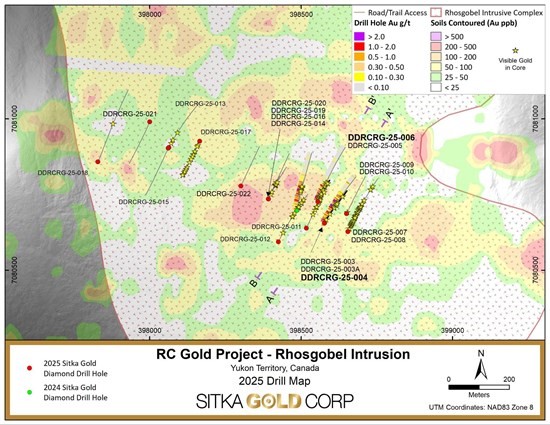
Figure 3: A plan map of the Rhosgobel Intrusion showing the 2025 drilling. The drilling is targeted based on previous shallow reverse-circulation drilling conducted in 1995 which had not been followed up on until Sitka’s initial diamond drill discovery holes completed in 2024. The target is supported by a large 2.0 km x 1.5 km gold-in-soil anomaly which covers the central part of the intrusion. All holes have intersected reduced intrusion-related gold (RIRGS) style mineralization including centimetre-scale, sheeted, quartz veins and larger, metre-scale quartz, and quartz-tourmaline veins (and breccias) cutting the feldspar megacrystic quartz monzonite intrusion. Multiple occurrences of visible gold have been observed in several of the diamond drill holes completed to date (yellow stars).
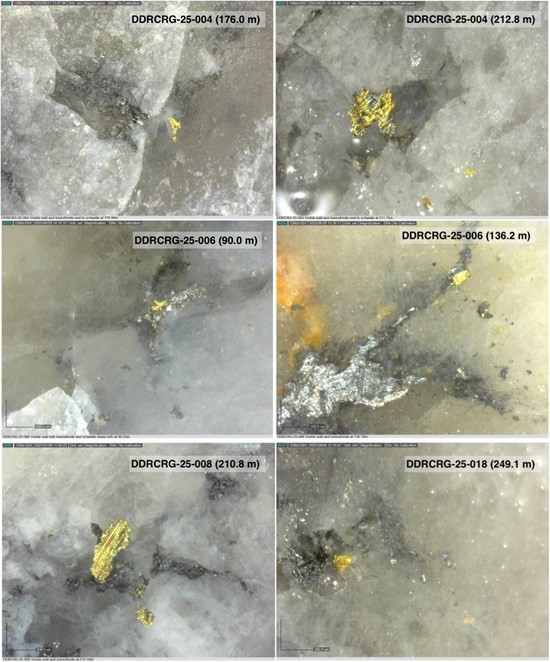
Figure 4: Examples of visible gold (VG) observed in DDRCRG-25-004, 006, 008 and 018 at the Rhosgobel target. Multiple occurrences of visible gold (VG) have been observed in the drill core at Rhosgobel, with VG encountered in 16 of the 22 holes completed to date. Bismuthinite, scheelite and molybdenite are also visible in the examples above and are associated with VG in many instances. Click HERE to view additional images of VG observed in Rhosgobel drill core.
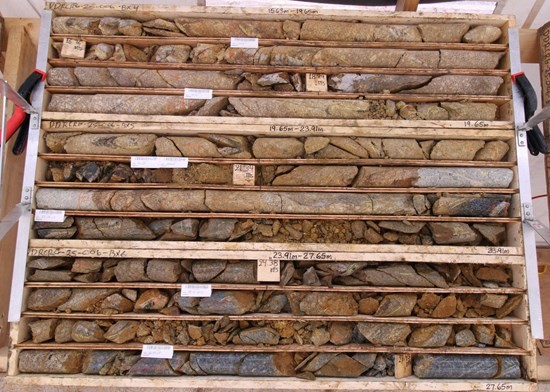
Figure 5: An example of drill core from DDRCRG-25-006 showing part of the interval of 8.0 m of 4.86 g/t Au starting at 13.0 m downhole within the broader interval of 166.0 m of 1.14 g/t Au from surface. The interval is hosted within altered and oxidized megacrystic quartz monzanite.
RHOSGOBEL DRILLING
To date, 22 holes totalling approximately 6,438 m have been completed at Rhosgobel. All holes drilled have intersected significant reduced intrusion-related gold (RIRGS) style mineralization including centimetre-scale, sheeted, quartz veins and larger, metre-scale quartz, and quartz-tourmaline veins (and breccias) cutting the feldspar megacrystic quartz monzonite intrusion. Visible gold has been observed within all styles of veins and is often associated with bismuthinite, scheelite, and molybdenite (see Figure 4). Drilling to date has traced mineralization over a strike length of approximately 900 metres within a large 2.0 km x 1.5 km surface signature represented by a gold-in-soil anomaly with values up to >500 ppb (Figure 3). The mineralization at Rhosgobel remains open in all directions. The first six diamond drill holes, including the two discovery holes drilled in 2024, have all intersected >100 gram-metres gold (g/t Au*m).
DDRCRG-25-006 returned 166.0 m of 1.14 g/t gold from surface including 8.0 m of 4.86 g/t gold from 13.0 m. Assays from DDRCRG-25-004 returned 238.0m of 0.6 g/t gold from surface, including 20.1 m of 1.02 g/t gold from surface, 18.9 m of 1.36 g/t gold from 100m and 14.1 m of 1.06 g/t gold from 138.8 m. Holes 004 and 006 were drilled from the same locations as Holes 003 and 005 on sections (see Figures 1 and 2) approximately 50 and 100m along strike from discovery holes 001 and 002 which returned 164.8 metres of 0.82 g/t gold from 9.1 metres including 119.0 metres of 1.05 g/t gold from 30.0 metres and 173.3 metres of 0.6 g/t gold from 97.0 metres including 28.4 m of 1.37 g/t gold from 105.0 metres respectively (see news release dated November 25, 2024).
* While visible gold observations are very encouraging and confirm the presence of gold mineralization, they are not intended to imply potential gold grades. Gold assays will be published after they are received from the lab for mineralized intervals in which visible gold particles were noted.
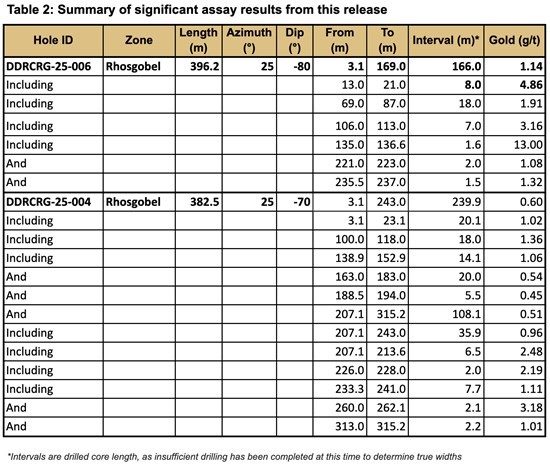
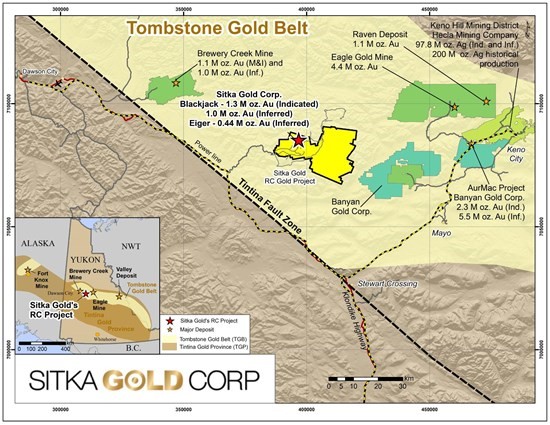
Figure 6: Regional map of the RC Gold Project located in the western portion of Yukon’s prolific Tombstone Gold Belt.

Figure 7*: A plan map of the Clear Creek Intrusive Complex (CCIC) showing the updated resource areas at Blackjack and Eiger, and the six additional areas that have drill targets indicated by the mauve hatched areas. The map highlights the numerous drill targets that Sitka has outlined within the CCIC which all are connected by the road network on the project and occur in an area measuring five (5) km north-south and twelve (12) km east-west. Additional areas highlighted by strong gold in soil anomalies are being advanced to the drill ready stage with additional geological work in 2025.
* References for Figure 7 drilling intervals:
Rhosgobel Intervals: Sitka Gold News Release dated November 25, 2024
Pukelman Intervals: Sitka Gold News Release dated January 7, 2025
Contact Intervals: O’Brien, 2010; Assessment Report, 2010 Diamond Drilling Program, Clear Creek Property (Assessment report 095539)
Shutty, 2011; Assessment Report, 2011 Exploration Program, Clear Creek Property (Assessment Report 095984)
Bear Paw Intervals: Shutty, 2011; Assessment Report, 2011 Exploration Program, Clear Creek Property (Assessment Report 095984)
Quality Assurance/Quality Control
On receipt from the drill site, the HTW/NTW-sized drill core was systematically logged for geological attributes, photographed and sampled at Sitka’s core logging facility. Sample lengths as small as 0.3 m were used to isolate features of interest, otherwise a default 2 m downhole sample length was used. Each sample is identified by a unique sample tag number which is placed in the bag containing the core to be assayed. Core was cut in half lengthwise along a predetermined line, with one-half (same half, consistently) collected for analysis and one-half stored as a record. Standard reference materials, blanks and duplicate samples were inserted by Sitka personnel at regular intervals into the sample stream. Bagged samples were placed in secure bins to ensure integrity during transport. They were delivered by Sitka personnel or a contract expeditor to ALS Laboratories’ preparatory facility in Whitehorse, Yukon, with analyses completed in North Vancouver.
ALS is accredited to ISO 17025:2005 UKAS ref. 4028 for its laboratory analysis. Samples were crushed by ALS to over 70 per cent passing below two millimetres and split using a riffle splitter. One-thousand-gram splits were pulverized to over 85 per cent passing below 75 microns. Gold determinations are by fire assay with an inductively coupled plasma mass spectroscopy (ICP-AES) finish on 50 g subsamples of the prepared pulp (ALS code: Au-ICP-22). Any sample returning over 10 g/t gold was re-analyzed by fire assay with a gravimetric finish on a 50 g subsample (ALS code: Au-GRA21). In addition, a 51-element analysis was performed on a 0.5 g subsample of the prepared pulps by an aqua regia digestion followed by an inductively coupled plasma mass spectroscopy (ICP-MS) finish (ALS code: ME-MS41).
About Sitka’s Flagship RC Gold Project
Sitka’s 100% owned RC Gold Project consists of a 431 square kilometre contiguous district-scale land package located in the heart of Yukon’s Tombstone Gold Belt. The project is located approximately 100 kilometres east of Dawson City, which has a 5,000 foot paved runway, and is accessed via a secondary gravel road from the Klondike Highway which is usable year-round and is an approximate 2 hour drive from Dawson City. It is the largest consolidated land package strategically positioned mid-way between the Eagle Gold Mine and the past producing Brewery Creek Gold Mine.
The RC Gold Project now has pit-constrained mineral resources that are contained in two zones: the Blackjack and Eiger gold deposits with 1,291,000 ounces of gold in 39,962,000 tonnes grading 1.01 g/t gold in an indicated category and 1,044,000 ounces of gold in 34,603,000 tonnes grading 0.94 g/t in an inferred category at Blackjack and 440,000 ounces of gold in 27,362,000 tonnes grading 0.50 g/t gold in an inferred category at Eiger. These resource estimate numbers are supported by the recently updated technical report for RC Gold, prepared in accordance with NI 43-101 standards, entitled “Clear Creek Property, RC Gold Project NI 43-101 Technical Report Dawson Mining District, Yukon Territory”, prepared by Ronald G. Simpson, P. Geo., of GeoSim Services Inc. with an effective date of January 21, 2025. This report is available on SEDAR+ (http://www.sedarplus.ca) and on the Company’s website (www.sitkagoldcorp.com).
Both of these deposits begin at surface, are potentially open pit minable and amenable to heap leaching, with initial bottle roll tests indicating that the gold is not refractory and has high gold recoveries of up to 94% with minimal NaCN consumption (see News Release July 13, 2022).
As of the end of 2024, the Company has drilled 72 diamond drill holes into this system for a total of approximately 25,136 metres. Other targets drilled to date include the Saddle, Josephine, Rhosgobel and Pukelman zones. The resource expansion drilling in 2023 at Blackjack produced results of up to 219.0 metres of 1.34 g/t gold including 124.8 metres of 2.01 g/t gold and 55.0 metres of 3.11 g/t gold in drill hole DDRCCC-23-047 (see news release dated September 26, 2023) and in 2024 results of up to 678.1 metres of 1.04 g/t gold starting from surface in DDRCCC-24-068, including 409.5 metres of 1.36 g/t gold, 93.0 metres of 2.57 g/t gold and 5.5 metres of 17.59 g/t gold (see news release dated October 21, 2024). Results from DDRCCC-25-075, completed during winter drilling in 2025, produced the best high-grade intercepts drilled to date at Blackjack, returning 352.8 metres of 1.55 g/t gold including 108.9 metres of 3.27 g/t gold and 45.0 metres of 4.52 g/t gold (see news release dated April 22, 2025).
A planned 30,000 metre diamond drilling program for 2025 is currently underway at RC Gold.
RC Gold Deposit Model
Exploration on the Property has mainly focused on identifying an intrusion-related gold system (“IRGS”). The property is within the Tombstone Gold Belt which is the prominent host to IRGS deposits within the Tintina Gold Province in Yukon and Alaska. Notable deposits from the belt include: Fort Knox Mine in Alaska with current Proven and Probable Reserves of 230 million tonnes at 0.3 g/t Au (2.471 million ounces; Sims 2018)(1); Eagle Gold Mine with current Measured and Indicated Resources of 233 million tonnes at a grade of 0.57 g/t Au at the Eagle Main Zone (4.303 million ounces; Harvey et al, 2022)(2); the Brewery Creek deposit with current Indicated Mineral Resource of 22.2 million tonnes at a gold grade of 1.11 g/t (0.789 million ounces; Hulse et al. 2020)(3); the AurMac Project with an Indicated Mineral Resource of 112.5 million tonnes grading 0.63 gram per tonne gold (2.274 million ounces)(4) plus an Inferred resource of 280.6 million tonnes grading 0.60 g/t gold (5.454 million ounces)(4), the Valley Deposit, with a current Measured and Indicated Mineral Resource of 7.94 million oz gold at 1.21 g/t and an additional Inferred Mineral Resource of 0.89 million oz at 0.62 g/t gold(5), and the Raven deposit with an inferred mineral resource of 1.1 million oz (19.96 million tonnes at 1.67 g/t gold)(6). The QP has been unable to verify the information regarding the above resource estimations and the information is not necessarily indicative of the mineralization on the property that is the subject of the disclosure.
(1) Sims J. Fort Knox Mine Fairbanks North Star Borough, Alaska, USA National Instrument 43-101 Technical Report. June 11, 2018. https://s2.q4cdn.com/496390694/files/doc_downloads/2018/Fort-Knox-June-2018-Technical-Report.pdf
(2) Harvey N., Gray P., Winterton J., Jutras M., Levy M.,Technical Report for the Eagle Gold Mine, Yukon Territory, Canada. Victoria Gold Corp. December 31, 2022. https://vgcx.com/site/assets/files/6534/vgcx_-_2023_eagle_mine_technical_report_final.pdf
(3) Hulse D, Emanuel C, Cook C. NI 43-101 Technical Report on Mineral Resources. Gustavson Associates. May 31, 2020. https://minedocs.com/22/Brewery-Creek-PEA-01182022.pdf
(4) July 8, 2025,Banyan Gold Corp., News Release. https://banyangold.com/news-releases/2025/banyan-announces-first-indicated-mineral-resources-and-identifies-high-grade-continuous-zones-at-its-aurmac-project-yukon-canada/
(6) Jutras, M. 2022. Technical Report on the Raven Mineral Deposit, Mayo Mining District Yukon Territory, Canada, prepared for Victoria Gold Corp and filed on SEDAR (www.sedar.com) with an effective date of September 15, 2022
About Sitka Gold Corp.
Sitka Gold Corp. is a well-funded mineral exploration company headquartered in Canada. The Company is managed by a team of experienced industry professionals and is focused on exploring for economically viable mineral deposits with its primary emphasis on gold, silver and copper mineral properties of merit. Sitka is currently advancing its 100% owned, 431 square kilometre flagship RC Gold Project located within the Tombstone Gold Belt in the Yukon Territory. The Company is also advancing the Alpha Gold Project in Nevada and currently has drill permits for its Burro Creek Gold and Silver Project in Arizona and the Coppermine River Project in Nunavut, all of which are 100% owned by the Company.
MORE or "UNCATEGORIZED"
Kuya Silver Confirms High-Grade Silver-Gold Vein Mineralization at Umm-Hadid with Initial Drill Results up to 1483.9 g/t AgEq over 2 Metres
Kuya Silver Corporation (CSE: KUYA) (OTCQB: KUYAF) (FSE: 6MR1) is... READ MORE
First Phosphate Closes Final Tranche of Oversubscribed Private Placement
First Phosphate Corp. (CSE: PHOS) (OTCQX: FRSPF) (FSE: KD0) is... READ MORE
GFG Receives Final Payment from the Sale of its Rattlesnake Hills Gold Project
GFG Resources Inc. (TSX-V: GFG) (OTCQB: GFGSF) announces that i... READ MORE
Goliath Receives $1,730,882 Through Warrant Exercises, Inclusive Of Crescat Capital A Longtime Strategic And Cornerstone Shareholder
Goliath Resources Limited (TSX-V: GOT) (OTCQB: GOTRF) (FSE: B4IF)... READ MORE
Robex Pours First Gold at Kiniéro on Schedule and Budget
Highlights: Gold bar weighing 2.64 kilograms (85 oz) poured in th... READ MORE












